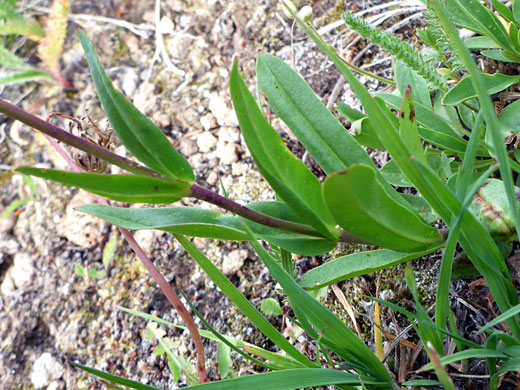Penstemon Procerus, Littleflower Penstemon
Plants > Wildflowers > Plantaginaceae > Penstemon Procerus
Common names:
Littleflower penstemon, pincushion penstemon
Family:
Scientific name:
Penstemon procerus
Main flower color:
Range:
The Rocky Mountain states and all states to the west, except Arizona
Height:
Up to 15 inches
Habitat:
Meadows, open woodland, alpine slopes, from 1,500 to 13,000 feet
Leaves:
Obovate to oblanceolate or lanceolate, basal and (opposite) cauline
Season:
June to August
Identifying features of penstemon procerus include the hairless anthers and hairless inflorescence, the relatively broad leaves, and the clustered flowers, in a spherical grouping at the top of the stem, and one or more closely-spaced whorls just below. This species has a wide distribution over a large elevation range, from the Rocky Mountains in Colorado across to California and the Pacific Northwest, resulting in variation of such aspects as height, leaf width and pubescence; six varieties are recognized.
Other plant parts are also usually glabrous, though the lower stem may have a covering of very short hairs. Leaves grow around the base and all the way along the stem; stem leaves are smaller. Calyx loves are ovate, quite pointed at the tip, and are much shorter than the tubular corolla, which widens only slightly from the base, opening to a two-lobed upper lip and a longer, three-lobed lower lip; all lobes are recurved by a similar amount. The base of the lower lobes is whitish on the inside. The tip of the infertile stamen usually has a few orange hairs.
Other plant parts are also usually glabrous, though the lower stem may have a covering of very short hairs. Leaves grow around the base and all the way along the stem; stem leaves are smaller. Calyx loves are ovate, quite pointed at the tip, and are much shorter than the tubular corolla, which widens only slightly from the base, opening to a two-lobed upper lip and a longer, three-lobed lower lip; all lobes are recurved by a similar amount. The base of the lower lobes is whitish on the inside. The tip of the infertile stamen usually has a few orange hairs.
All Contents © Copyright The American Southwest | Comments and Questions | Contribute | Site Map


